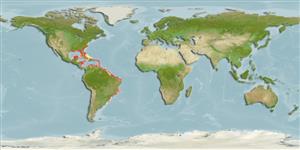Common names from other countries
Classification / Names / Names
Common names | Synonyms | Catalog of Fishes (gen., sp.) | ITIS | CoL | WoRMS
Environment: milieu / climate zone / depth range / distribution range
Ecology
Benthopelagic; depth range 0 - 75 m (Ref. 367). Tropical; 18°C - 31°C (Ref. 367); 38°N - 34°S, 94°W - 32°W
Western Atlantic: USA to Brazil. Tropical to subtropical.
Length at first maturity / Size / Weight / Age
Maturity: Lm 3.8 range ? - ? cm Max length : 13.0 cm CW male/unsexed; (Ref. 367); 11 cm CW (female); max. reported age: 2.40 years (Ref. 85497)
Carapace slightly more than twice as broad as long; 9 teeth on arched anterolateral margin (outer orbital tooth and strong lateral spine included) progressively more acuminate laterally; outer pair of frontal teeth (excluding inner orbital angles) prominent but inner pair small, often almost completely rudimentary. Much of convex dorsal surface lightly granulate, most prominently so on anterior and elevated areas and in transverse lines; central trapezoidal (metagastric) area short and wide (anterior width about 2.8 times, posterior width about 1.75 times length). Pincers dissimilar, ridged longitudinally; fifth legs flattened in form of paddles. Male with T-shaped abdomen reaching slightly beyond suture between thoracic sternites 4 and 5, usually with distal parts recessed below plane of sternum in retracted position. First pleopods overlapping proximally, nearly straight distally, terminating in usually lanceolate membranous tip near level of suture between thoracic sternites 6 and 7, armed subterminally with short retrogressive spinules. Color: variable. Light greyish green, olive, pinkish, or brown, spines maroon to blue or white, white-tipped; pincers with outer face white, inner surface dark blue; varying transverse light-dark bands on paddles, other legs tinted blue; underparts whitish to grey.
Minimum carapace width: 0.94 cm (Ref. 93549). Minimum depth from Ref. 101595.
Life cycle and mating behavior
Maturity | Reproduction | Spawning | Eggs | Fecundity | Larvae
Members of the order Decapoda are mostly gonochoric. Mating behavior: Precopulatory courtship ritual is common (through olfactory and tactile cues); usually indirect sperm transfer.
Melo, G.A.M. 1996. (Ref. 8729)
IUCN Red List Status (Ref. 130435: Version 2024-1)
CITES status (Ref. 108899)
Not Evaluated
Not Evaluated
Human uses
Fisheries: commercial
| FishSource |
Tools
Internet sources
Estimates based on models
Preferred temperature
(Ref.
115969): 22.6 - 28, mean 25.7 (based on 456 cells).
Resilience
High, minimum population doubling time less than 15 months (K=1.83; tmax=2.4).
Vulnerability
Low vulnerability (10 of 100).
